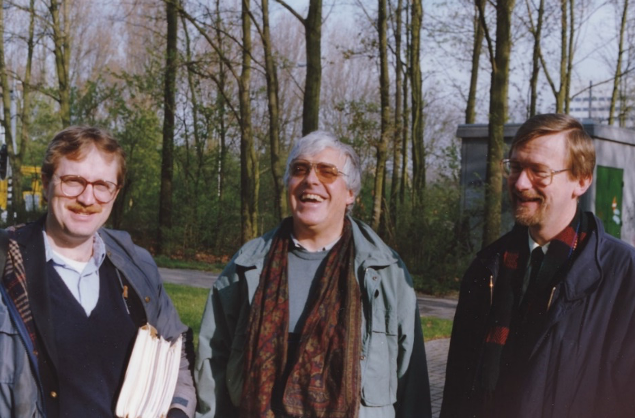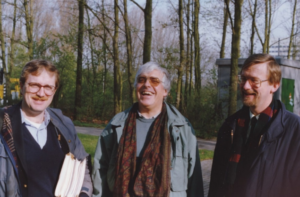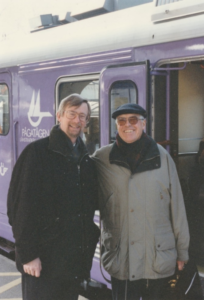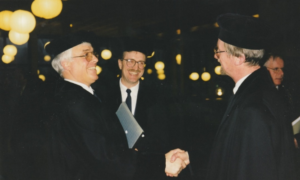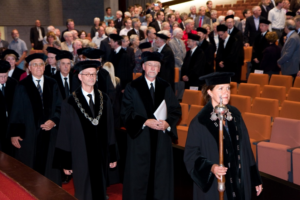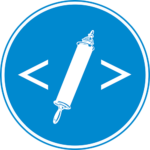By Eep Talstra
On May 8 2020 my dear long-time friend and colleague, Christof Hardmeier, passed away, at the age of 77. A man of great talents, he was capable of participating intensely in various domains of life: theology, churches, political activities, literature, software development. In this tribute to his life I concentrate on the domain of research that we particularly shared: Bible and computer-assisted methods of textual research.
Pioneering
To many involved in Old Testament studies, Christof was a most inspiring teacher due to his creative thinking and his ability to connect various disciplines of the Humanities. As early as 1970 Christof published an article reporting on his own experiments with computer programming for the linguistic analysis of biblical Hebrew: ‘Die Verwendung von elektronische Datenverarbeitungsanlagen in die alttestamentliche Wissenschaft. Neue Möglichkeiten der Forschung am Alten Testament’, Zeitschrift für die alttestamentliche Wissenschaft 83 (1970), 175-185. He envisioned possibilities for textual research beyond the use of traditional concordances. Besides the search for words used in the Hebrew Bible, one should also be able to search for grammatical functions, such as verbal features, independently from the words carrying those functions. He thus became an early pioneer in the field of linguistic analysis and the use of computers in biblical studies.
However, sometimes even a pioneer can begin too early. In the era of main frame computers, punch cards, and limited possibilities for storing and processing Hebrew texts, Christof found himself engaged in a twofold task. Not only did he need to master a new technology, but he also aimed at developing a new exegetical methodology. That task became the leading theme in his work as a biblical scholar and theologian. Rather than the traditional approach of trying to understand the mind and the theology of a text’s author, Christof explored the role of language in the process of communication between texts and their ancient and current readership. To do the first, it was sufficient to have a knowledge of words and concepts, but to do the latter, researchers would need a knowledge of grammar and syntax. For that Christof needed to use computers. However, he did not at first find much support.
Fulda and Bielefeld
We first met in 1983 at a conference of teachers of Biblical Hebrew in Fulda, Germany. Wolfgang Schneider, whose Grammar of Biblical Hebrew I had reviewed, had invited me to present a paper on my work on text grammar and the use of computers. Christof, then teaching Biblical Hebrew at the Seminary of Bielefeld, attended this meeting. As he told me later, he was surprised to find that Bible and computer apparently was a topic of research and not only a means for speeding up the production of classical instruments such as lexical concordances. After his first attempts to write programs for linguistics analysis on a main frame computer in Heidelberg, he had given up, since he did not receive much encouragement from biblical scholars in those days. I, in turn, could tell him that when I started the research on Bible and computer in 1977, his article of 1970 had stimulated me more than any other early computer project, since we both clearly agreed on the priority of studying the syntax and linguistic signals of communication.
After the Fulda meeting, Christof’s old love for computer-assisted textual analysis revived. Within a few months he came to Amsterdam to discuss collaboration. Since he did not have access to sufficient computer facilities at the Seminary in Bielefeld (for doing research we were still in the era of main frame computers), we agreed upon a practical division of labour. In Amsterdam we would continue with the research that was part of the construction of a database of linguistically analysed Hebrew texts. Christof would experiment with our results and continue his theoretical work on literary analysis, linguistics, and communication. Together we would try to develop a model for an effective interface to the Amsterdam database to be used by biblical scholars in general.
ECA and AIBI
At that time we began to attend conferences to present papers on Bible and computer, each from his own perspective. In the early 80s Frère Ferdinand Poswick of the Abbey of Maredsous (Belgium) had founded AIBI: Association International Bible et Informatique. In 1985 the first AIBI conference was organized in Louvain-la-Neuve, where both Christof and I each presented a paper. In his contribution Christof’s scholarly program was clearly phrased: ‘Elektronische Datenverarbeitung als Instrument der Analyse von hebräische Texten des Alten Testaments‘. That is: we need a precision instrument for linguistic observations that at the same time allows for creative literary research. Much of his later research became an elaboration of the principles outlined in that presentation.
AIBI1 turned out to be the beginning of a series of meetings, conferences, and project plannings, in which we often both participated. This continued for nearly 25 years. All of these occasions were to demonstrate the interaction of linguistic thinking, the design of computer programming, and a method for reading texts as domains of linguistic and religious communication.
In 1987 we took part in a conference of professors of Hebrew in Stuttgart, presenting our aspirations and our findings on Hebrew grammar and computer, and again in the same year at the Internationale Theologen Konferenz in Vienna. Also that year the research group on Bible and computer in Amsterdam celebrated its 10thanniversary and Christof came to speak of his ideas and experiments on what he called a ‘dialogfähige Konkordanz’, an interactive instrument that would allow you to do text searches and iteratively use the results as input for refinement and further searches.
At this occasion we met for the first time our colleague, Alan Groves, professor of Hebrew at Westminster Seminary in Philadelphia. He presented a paper on his own work with a Hebrew text database in Philadelphia. Alan soon became our third man, contributing a vast amount of experience to the field. We became a team, called ECA. This name was coined by Christof: to the outside world it would refer to ‘Electronic Concordance Applications’, to the initiated it would simply mean: ‘Eep, Christof, Alan’. The team continued for twenty years until Alan’s early death in 2007.
With his paper ‘Computer concordance able to dialogue’ at the second AIBI conference in Jerusalem (1988), Christof further elaborated on his ideas about the methodology of linguistic research and biblical literature. His work often generated lively debates on what one could call the necessary interaction of the artist and the engineer in biblical studies. Christof invested much energy in this research and in the necessary team building, as can be observed from conferences he organized, such as in 1988 at his own Seminary in Bielefeld, and several articles intended for a larger audience of biblical scholars. Together we published ‘Sprachgestalt und Sinngehalt. Wege zu neuen Instrumenten der computergestützten Textwahrnehmung‘,Zeitschrift für die alttestamentliche Wissenschaft101 (1989), 408-428.
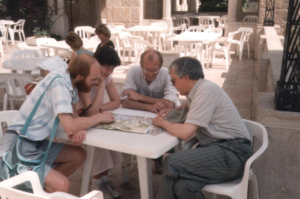
AIBI2, Jerusalem 1988: Albert Beetsma, Janet Dyk, Arian Verheij, Christof Hardmeier, preparing for a city tour
Christof’s contribution ‘Computer assisted Perception of Texts and its Hermeneutic Relevance’ to the third AIBI conference in Tübingen 1991 made it quite clear how audacious his scholarly program was and how much team building was needed. First, computer specialists were needed for programming the search for linguistic patterns in the Hebrew texts as they have been transmitted to us (parole). Next, linguists were needed to identify the systematic relationships of patterns and functions (langue), to apply this knowledge again to the database to correct and iteratively update it. And, finally, it was necessary to continue to be exegetes using all the available linguistic instruments in the effort to understand the processes of communication within the texts and to the readers.
Christof invested time and energy in further team building and the search for funding, as we also did in Amsterdam. In this endeavour, good relationships established with both the German and the Netherlands Bible Societies were important. Janet Dyk joined the team as a linguist, Henk Harmsen and Constantijn Sikkel as computer specialists, and later also Ulrik Petersen (Univerity of Aalborg, Denmark). As a result, a first release of our database could be published in 1992, with a query system as Christof had wished for for so long.
Greifswald and SESB
Due to his move from Bielefeld to a new position as professor of Old Testament in Greifswald, Christof was unable to help prepare for and attend the fourth AIBI conference in Amsterdam in 1994, but the next year we could join forces again on the occasion of the PhD defence by Nicolai Winther-Nielsen in March 1995, in Lund, Sweden. Nicolai’s PhD thesis on the book of Joshua constructed an effective bridge between the methods of data base construction in Amsterdam and the thinking about text and communication in Greifswald. Christof enjoyed participating in this event in Lund.
In his new position in Greifswald Christof continued to combine his interests in methods of exegesis with the Hebrew database project. In 1995 he organised a symposium on ‘Bible and Computer’ in Greifswald, and in 1998 one with the telling title: Ad Fontes, emphasizing once more his fundamental hermeneutical attitude.
Henk Harmsen’s PhD defence in 1998, on his research in algorithms for participant tracking applied to the book of Deuteronomy, presented a nice opportunity for the ECA to come together again. Both Christof and Alan were members of the PhD examination committee, taking part in the ceremony and for the occasion both being dressed up as real Dutch professors.
In the meantime (1997, Stuttgart), we were making plans for a second release of Quest in collaboration with the German and the Dutch Bible Societies and the research group of Alan Groves in Philadelphia. But the times were also changing rapidly: we now had to compete with other Bible software designed for Bible translators, while we were also striving to continue as a project for methodological sound biblical research. The result was a new project: SESB (Stuttgart Electronic Study Bible), produced in 2004, in close cooperation with Logos software.
The next stage
To Christof, and to me as well, it became clear that the ‘do-it-yourself’ phase of pioneering with computers and simultaneously experimenting with new methods of textual analysis had nearly run its course. It was time to direct our attention to what the next generation of researchers had in mind and how they would manage to find a balance between the new opportunities of the internet, the growing amount of software tools now available in E-Humanities, while still staying independent in terms of the methodology of our own scholarly work with biblical texts.
Consequently, we started to act somewhat more like grandfathers with our own skills and experiences, but no longer fully responsible for all the new developments. This began more or less when in 2000 Christof and I travelled to New York to a conference organized by the American Bible Society on the theme ‘Critical thinking and the Bible in the Age of the New Media’. Alan Groves was also present. Christof enjoyed this occasion to explain his views on Bible and methods to a completely new audience. Critical thinking and analysing, he made clear, is not a new method that needs to be brought from outside into biblical studies. On the contrary, careful computer-assisted reading will help us detect the attitude of critical thinking present in the biblical texts themselves. That is basic to theology.
In 2006 we met in Haarlem at the Netherlands Bible Society to prepare for a next release of SESB. Now scholarly thinking about the linguistic data types became the most important issue for Christof and me. Constructing and testing software able to recognize or to redefine linguistic data types present in texts had become more and more the work of the next generation: Constantijn Sikkel, Ulrik Sandborg-Petersen, and others. The grandfathers did not regret that in this respect our pioneering activities had been completed.
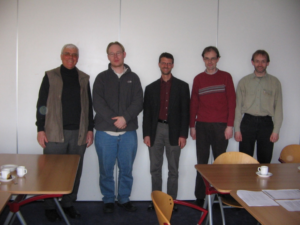
Haarlem, NBG 2006: Christof, Ulrik Sandborg-Petersen, Bertram Salzman (DBG), Dave van Grootheest (NBG), Constantijn Sikkel
Finally, two more or less culminating events in which Christof enjoyed participating need to be mentioned. In 2011 I retired from the chair of Old Testament studies. Christof was with us as a guest of honour at the celebration, again we saw him fully dressed as a Dutch university professor, which he enjoyed.
October 2017 marked the fortieth anniversary of the founding of the research group of Bible and Computer at the Faculty of Theology at the Vrije Universiteit of Amsterdam. Christof came from Berlin to celebrate with us and to cherish common memories. Together we could enjoy the presentations given by the next generation of researchers. He was now fully content to adopt the role of academic grandfather, he whispered into my ears.
I felt it my duty to share a number of memories with the biblical scholars who now have become our successors, just to give them an impression of what the pioneering phase was like and how important the friendships were that forged in it.
To Christof the sayings of both the Hebrew and the Greek tradition fully apply. As it is phrased in Proverbs 10:7 זכרונו לברכה‘His memory is a blessing’. In addition to that also the words written by Paul in Romans 14:8, quoted on the funeral card:ἐάν τε οὖν ζῶμεν ἐάν τε ἀποθνῄσκωμεν, τοῦ κυρίου ἐσμέν. ‘Whether we live or whether we die, we are the Lord’s’.
May 27, 2020
Eep Talstra

